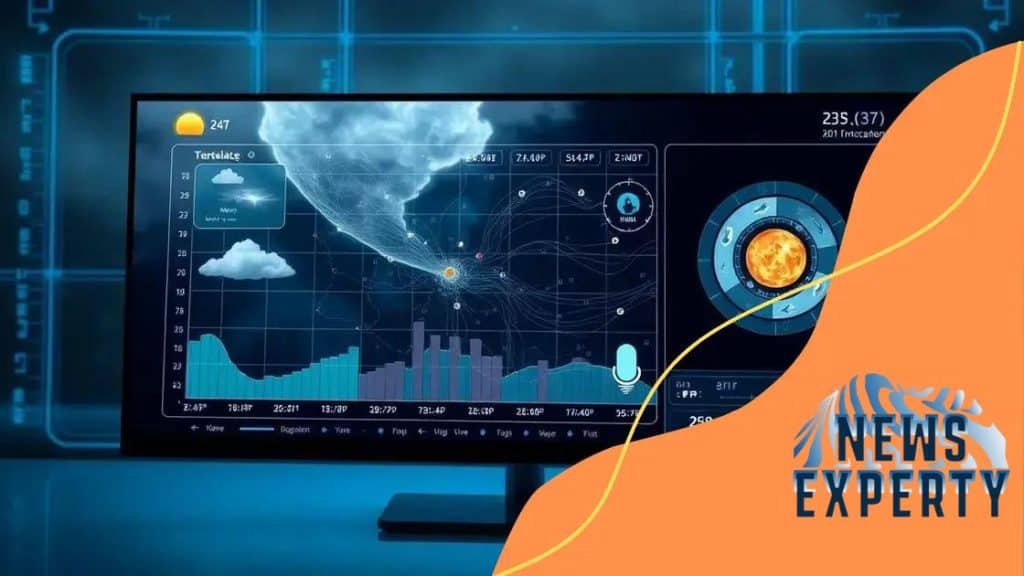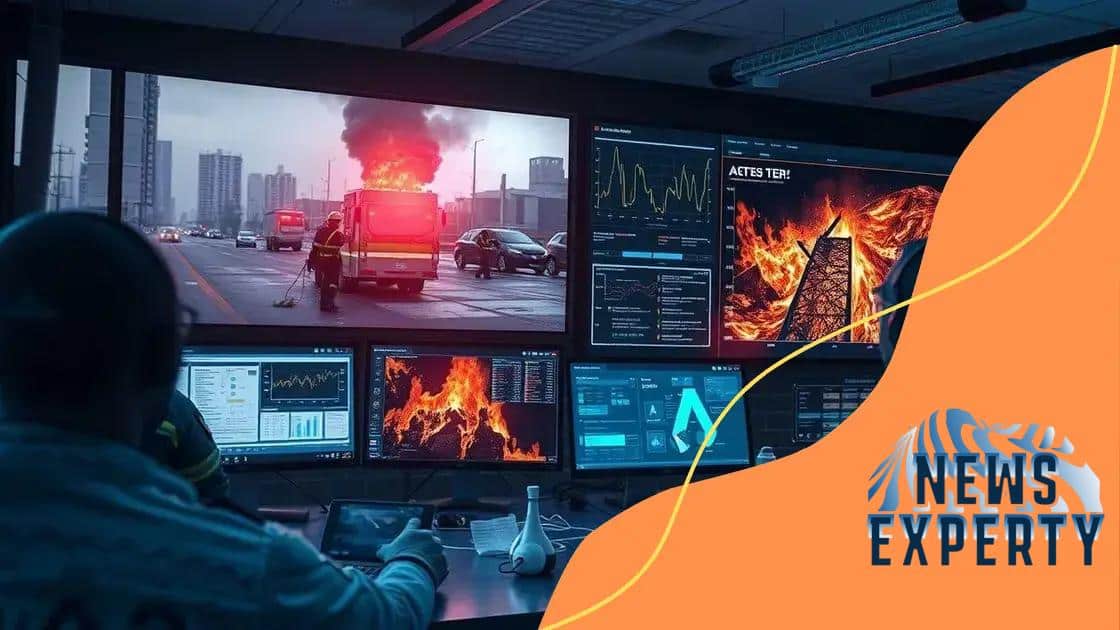The role of AI in predicting natural disasters

Anúncios
The role of AI in predicting natural disasters is crucial as it enhances accuracy in forecasting, improves resource allocation, and facilitates timely communication, ultimately saving lives and reducing damage during emergencies.
The role of AI in predicting natural disasters is gaining attention as more technologies emerge. Ever thought about how AI could save lives during unexpected events? This article delves into the incredible potential.
Anúncios
Understanding AI’s capabilities
Understanding AI’s capabilities is essential for harnessing its power in various fields, especially in forecasting natural disasters. With its ability to process vast amounts of data swiftly, AI can identify patterns that are beyond human comprehension. This article will explore the significant aspects of AI that enhance its predictive abilities.
Data Processing and Analysis
AI algorithms excel in data processing. By analyzing historical data and real-time information, these systems can predict environmental changes accurately. The use of machine learning allows AI to learn from past events, improving its future predictions.
Integration with Other Technologies
Another reason AI is so effective is its ability to integrate with other technologies. For example, when combined with satellite imagery, AI can monitor weather systems in real-time. This synergy helps in:
Anúncios
- Enhancing accuracy of predictions.
- Providing timely alerts to communities.
- Improving the overall response to natural disasters.
The synergy between AI and these technologies enables us to stay a step ahead of natural calamities.
As AI continues to evolve, new methodologies emerge regularly. Techniques such as predictive modeling are now at the forefront, helping scientists simulate potential disaster scenarios. These models use current data to forecast future events, providing a clearer picture of what may happen. However, challenges remain.
Despite its advantages, there are obstacles in utilizing AI for disaster prediction effectively. Data quality and availability can vary, impacting the reliability of predictions. Moreover, understanding AI’s decision-making process can be complex. This complexity sometimes leads to hesitance in trusting the predictions AI makes, especially in high-stakes situations. Nonetheless, as AI technology advances, efforts to simplify these processes are ongoing.
In summary, understanding AI’s capabilities is vital in the attempt to predict natural disasters effectively. With continuous advancements and integrated systems, AI holds the promise of significantly enhancing our preparedness and response to emergencies. By leveraging its strengths, we can better safeguard communities and mitigate the impacts of unexpected natural events.
How AI analyzes weather patterns
How AI analyzes weather patterns is a fascinating topic, revealing the complexities of our environment. By using various algorithms, AI can sift through enormous data sets from satellites, weather stations, and sensors to detect changes in weather.
Data Sources and Their Importance
AI relies on numerous data sources that provide real-time information. These may include:
- Satellite imagery that captures cloud formations and temperature variations.
- Ground-based sensors that measure humidity, pressure, and wind speed.
- Historical weather data that helps identify trends.
This collection of data is essential for accurate analysis. The more data AI has, the better it can predict upcoming weather changes.
AI uses advanced machine learning techniques to identify patterns in this data. It can analyze how different weather elements interact and influence each other. For instance, the relationship between sea temperature and storm formation can be crucial. By examining these interactions, AI can provide valuable insights into weather trends.
With the ability to process information faster than humans, AI identifies anomalies in weather patterns. These anomalies can be early indicators of severe weather, such as hurricanes or tornadoes. Once detected, AI can issue warnings to officials and the public. This capability is vital for disaster response and preparation.
As technology evolves, AI continues to improve its analytical skills. New models and algorithms are being developed to enhance accuracy. These advancements mean that forecasting can become even more precise, helping communities better respond to potential disasters. Furthermore, improved AI technologies can analyze long-term climate changes and trends, giving us a clearer understanding of how our environment is changing.
Real-world applications of AI in disaster preparedness

Real-world applications of AI in disaster preparedness showcase how technology can significantly improve our response to crises. Many organizations are now using AI to enhance their emergency management strategies.
Predictive Analytics
One of the most impactful uses of AI is predictive analytics. By analyzing data on past disasters, AI models can forecast potential future events. This helps governments and agencies to:
- Prepare better resources.
- Issue timely warnings to the public.
- Plan evacuation routes more effectively.
This proactive approach can save countless lives during emergencies.
Another significant application of AI is in optimizing resource allocation. In the event of a disaster, knowing where to send aid quickly can make a huge difference. AI algorithms analyze various factors such as population density and the severity of the disaster to guide decisions on resource deployment.
AI also enables real-time monitoring of situations, allowing agencies to track changes as they occur. For instance, AI can analyze weather reports, social media updates, and sensor data all at once. This creates a comprehensive view of a disaster, informing responders of emerging situations.
The integration of AI into communication systems is enhancing the way information flows during a crisis. Automated systems can send alerts and updates to the public via multiple channels, including texts and social media. This ensures that people receive critical information quickly and accurately, reducing panic and confusion.
Furthermore, AI is making strides in training and simulation environments. Virtual reality (VR) and AI technologies together provide realistic training scenarios for first responders. These simulations prepare personnel for actual events, leading to more effective responses when real disasters occur.
Through these various applications, AI is reshaping how we prepare for and respond to disasters. Its ability to analyze data quickly and accurately offers invaluable support to emergency management efforts, ensuring communities are better equipped to handle crises.
Challenges in using AI for predictions
Challenges in using AI for predictions can significantly impact the effectiveness of disaster management. While AI has advanced rapidly, several hurdles remain that can hinder its implementation in real-world situations.
Data Quality and Availability
One major challenge is the quality of data. AI relies heavily on accurate and comprehensive data to make predictions. Issues like:
- Inconsistent data collection methods.
- Insufficient historical data for certain areas.
- Data biases leading to flawed predictions.
These factors can compromise the reliability of AI models, making it difficult to trust their forecasts.
Another challenge is the complexity of weather systems. AI models may struggle to account for interactions between various environmental factors. For example, predicting the exact path of a storm involves understanding changes in temperature, humidity, and wind patterns. Missing even a small piece of data can lead to significant errors in predictions.
Furthermore, the interpretability of AI algorithms poses additional issues. Many AI systems, particularly those using deep learning, function as “black boxes.” This means that even experts may find it challenging to understand how the AI reached a specific conclusion. This lack of transparency can hinder trust among decision-makers and the public when it comes to acting on AI predictions.
Operational challenges also play a role. Implementing AI systems requires significant investment in training personnel, updating infrastructure, and ensuring ongoing maintenance. Without proper support, organizations may face difficulties in maximizing AI’s potential in disaster management.
Despite these challenges, ongoing research and development aim to address these issues. Innovative solutions are being sought to improve data collection methods and increase the interpretability of AI models. With time and effort, the hurdles facing AI in disaster prediction may be overcome, enhancing its utility in saving lives and property.
Future trends in AI and disaster management
Future trends in AI and disaster management indicate a promising evolution in how we prepare for and respond to natural disasters. As technology continues to advance, AI’s role is expected to grow, providing even more innovative solutions.
Enhanced Predictive Models
Next-generation AI systems will harness improved algorithms, making predictions more accurate. This involves using larger data sets, which allow for better forecasting of disaster-related events. By integrating more variables, such as social media trends and environmental changes, AI can anticipate disasters sooner and with greater precision.
Real-time Data Utilization
The future will also see increased use of real-time data. With advancements in IoT (Internet of Things), more devices will collect relevant data. AI will process this information instantly, giving emergency responders crucial insights into evolving situations.
Applications like drone technology will become commonplace. Drones will collect data from hard-to-reach areas, providing AI with updated information on conditions during a disaster.
Additionally, AI will play a key role in improving communication during emergencies. Automated messages can simplify public alerts, ensuring timely information reaches those in need. Enhancing communication systems will reduce misinformation, which can lead to panic or confusion in disaster situations.
AI’s integration with other technologies, such as augmented reality (AR), will also revolutionize training for emergency responders. Simulations using AR will prepare personnel for real-life scenarios and enhance their effectiveness during actual disasters.
Moreover, community engagement will be a focus. AI tools can gather feedback from the public during and after disasters, helping agencies improve their response efforts. This data will refine strategies, making communities more resilient in the face of future challenges.
In summary, the future of AI in disaster management looks bright. With more advanced predictive models, real-time data utilization, and enhanced communication, we can expect to see significant improvements in how we handle disasters, ultimately saving lives and resources.
FAQ – Frequently Asked Questions About AI in Disaster Management
How does AI improve disaster prediction accuracy?
AI improves disaster prediction accuracy by analyzing vast amounts of data from various sources to identify patterns and forecast events.
What role do drones play in disaster management?
Drones are used to collect real-time data from disaster zones, providing valuable insights for emergency responders.
How does AI enhance communication during emergencies?
AI enhances communication by automating alerts and updates, ensuring timely information reaches the public and reducing confusion.
What is the importance of community engagement in disaster management?
Community engagement helps gather feedback, allowing organizations to improve their response efforts and increase resilience in future crises.





